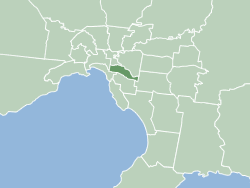
The City of Stonnington is a local government area located within the metropolitan area of Melbourne, Australia. It comprises the inner south-eastern suburbs, between 3 and 13 km, from the Melbourne CBD. The city covers an area of 25.7 km2 (9.9 sq mi).
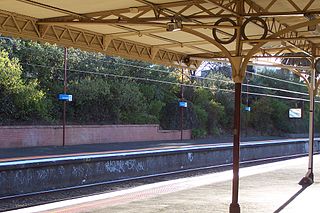
Armadale is an inner suburb in Melbourne, Victoria, Australia, 7 km south-east of Melbourne's Central Business District, located within the City of Stonnington local government area. Armadale recorded a population of 9,368 at the 2021 census.

Malvern ( ) is a suburb of Melbourne, Victoria, Australia, 8 km south-east of Melbourne's Central Business District, located within the City of Stonnington local government area. Malvern recorded a population of 9,929 at the 2021 census.

South Yarra is an inner-city suburb in Melbourne, Victoria, Australia, 4 km south-east of Melbourne's Central Business District, located within the Cities of Melbourne and Stonnington local government areas. South Yarra recorded a population of 25,028 at the 2021 census.

Toorak is a suburb of Melbourne, Victoria, Australia, 5 km (3.1 mi) south-east of Melbourne's Central Business District, located within the City of Stonnington local government area. Toorak recorded a population of 12,817 at the 2021 census.

Hawksburn railway station is a commuter railway station on the Frankston line, serving the south Melbourne suburb of South Yarra in Victoria, Australia. Hawksburn is a below ground unstaffed station, featuring four platforms with an island platform and two side platforms accessible by a pedestrian bridge. The station is listed on the Victorian Heritage Register, and was opened on 7 May 1879.
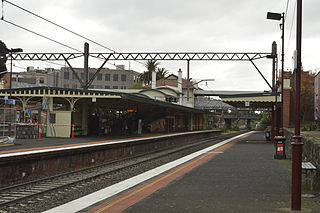
Malvern railway station is a commuter railway station that is part of the Melbourne railway network in Victoria, Australia. The station is located on the southern border of Malvern, a suburb of Melbourne, and was opened on 7 May 1879. The station complex consists of an island platform and two side platforms all accessed by a pedestrian bridge. There are two red brick Edwardian-era station buildings, constructed in 1914 as ticketing and staff offices. The entire complex is listed on the Victorian Heritage Register because of its architectural significance and its role in the development of Malvern as a significant metropolitan centre. The station is only partially accessible because of multiple steep access ramps.

Kooyong railway station is located on the Glen Waverley line in Victoria, Australia. It serves the eastern Melbourne suburb of Kooyong, and it opened on 24 March 1890.

Melbourne tram route 5 is operated by Yarra Trams on the Melbourne tram network from Melbourne University to Malvern. The 12.6-kilometre (7.8 mi) route is operated out of Malvern depot with Z and D1 class trams.

Chapel Street is a street in Melbourne, Victoria, running along the inner suburbs of South Yarra, Prahran, Windsor, St Kilda and St Kilda East.
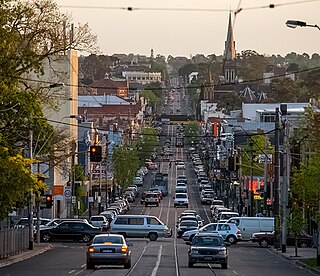
Glenferrie Road is a major north–south thoroughfare in Melbourne, Australia. It runs from Kew to Caulfield North, and includes major shopping districts at both Hawthorn and Malvern. There are a number of rail transport options on Glenferrie Road and also some landmarks.

The Scots' Church is a Presbyterian church in Collins Street, Melbourne, Victoria, Australia. Services are held at 11 am (traditional) and 5pm (contemporary). It is a reformed protestant church. It was the first Presbyterian church to be built in the Port Phillip District, and serves as a congregation of the Presbyterian Church of Australia. Its building was described as "an icon for well over a hundred years".

The Melbourne Hebrew Congregation, or Toorak Shule, is the oldest Jewish congregation in Melbourne, Victoria, Australia. Formed in 1841, the congregation was originally located on Bourke Street before moving in 1930 to Toorak Road, South Yarra.
George Fincham was an organ builder active in Australia.

Domain Interchange was a major interchange on the Melbourne tram system. It featured two island platforms with four tracks, and had dedicated turning tracks and through tracks. It was located on St Kilda Road between Domain Road and Park Street, adjacent to Kings Domain, and was one of the busiest interchanges on the system, being used by eight tram routes. A shelter built in 1986 was replaced when the stop was rebuilt in 2013.
Robert Joseph Haddon (1866–1929) was an England-born architect who practised in Victoria in the 1900s-1910s. He was a major figure in the profession in Victoria, championing the Arts & Crafts in his writing and teaching. He designed some of the most original buildings of the period, featuring restraint, balanced asymmetry and Art Nouveau details.
William Arthur Purnell FRAIA, generally known as Arthur Purnell, and sometimes A W Purnell, was an Australian-born architect who practised in Canton, China, in the 1900s, and from 1910 mainly in Melbourne, Australia. He is most noted for the few designs in Melbourne that include Chinese references.

Melbourne tram route 58 is operated by Yarra Trams on the Melbourne tram network from West Coburg to Toorak. The 18.0 kilometre route is operated out of Essendon and Southbank depots with Z, B and E class trams.
Sydney Wigham Smith was an architect in Melbourne, Australia, principal of the firm of Sydney Smith, Ogg and Serpell.
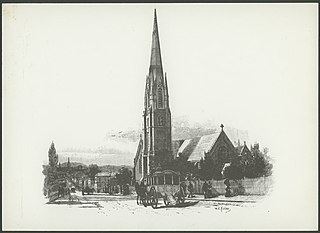
Christ Church, South Yarra is an Anglican church at 683-701 Punt Road, South Yarra in Melbourne, Victoria, Australia. Established in 1856, the congregation form part of the Anglican Diocese of Melbourne. The parish belongs to the Anglo-Catholic or High Church tradition; it was the location of the ordination of the first woman to be a deaconess in Australia in 1884.






























